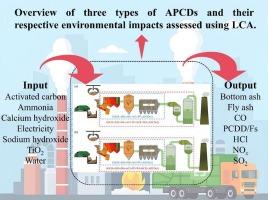中国城市生活垃圾焚烧厂超低排放技术生命周期评价
IF 7.1
2区 环境科学与生态学
Q1 ENGINEERING, ENVIRONMENTAL
引用次数: 0
摘要
焚烧是中国主要的城市固体废物(MSW)管理方法,但更严格的排放标准需要先进的空气污染控制(APC)技术,如选择性催化还原(SCR)和湿式洗涤(WS)进入城市固体废物焚烧厂,以实现超低排放(ULE)。在有效减少目标空气污染物的同时,这些ULE技术增加了能源和材料消耗,可能导致环境权衡。本研究通过比较中国城市生活垃圾焚烧厂的传统APC系统和ULE技术,采用生命周期评估来评估这些权衡。每焚化一吨都市固体废物编制了三个过程清单,分别代表一个常规系统(APCDs1)和两个ULE系统(APCDs2: scr优先;APCDs3: ws优先)。足迹法3.1版应用于评估环境影响。结果表明,APCDs1的整体环境影响潜力最低(8.37 × 10-3),其次是APCDs3 (8.67 × 10-3)和APCDs2 (8.72 × 10-3)。低能耗系统中能源和材料消耗增加所带来的全球变暖潜力的增加,往往超过了其他影响类别中减少空气污染物所带来的好处。这表明,在中国,优先考虑提供平衡环境绩效的短过程、协同控制污染技术可能比复杂的、资源密集型的ULE改造更具可持续性。研究结果为城市生活垃圾焚烧行业的知情技术选择和政策制定提供了重要的经验证据。本文章由计算机程序翻译,如有差异,请以英文原文为准。

Life cycle assessment of ultra-low emission technologies in China’s MSW incineration plants
Incineration is a dominant municipal solid waste (MSW) management method in China, but stricter emission standards necessitate advanced air pollution control (APC) technologies, such as selective catalytic reduction (SCR) and wet scrubbing (WS), into MSW incineration plants to achieve ultra-low emissions (ULE). While effective in reducing targeted air pollutants, these ULE technologies increase energy and material consumption, potentially leading to environmental trade-offs. This study employs life cycle assessment to evaluate these trade-offs by comparing conventional APC systems with ULE technologies in China’s MSW incineration plants. Three process inventories, representing a conventional (APCDs1) and two ULE (APCDs2: SCR-first; APCDs3: WS-first) systems, were developed per tonne of MSW incinerated. The footprint methods version 3.1 was applied to assess environmental impacts. The results indicate that the APCDs1 had the lowest overall environmental impact potential (8.37 × 10-3), followed by the APCDs3 (8.67 × 10-3) and APCDs2 (8.72 × 10-3). The increased global warming potential from higher energy and material consumption in ULE systems often outweighs the benefits from reduced air pollutants in other impact categories. This suggests that prioritizing short-process, co-control pollution technologies offering balanced environmental performance may be more sustainable than complex, resource-intensive ULE retrofits in China. The findings provide crucial empirical evidence for informed technology selection and policy development in the MSW incineration sector.
求助全文
通过发布文献求助,成功后即可免费获取论文全文。
去求助
来源期刊

Waste management
环境科学-工程:环境
CiteScore
15.60
自引率
6.20%
发文量
492
审稿时长
39 days
期刊介绍:
Waste Management is devoted to the presentation and discussion of information on solid wastes,it covers the entire lifecycle of solid. wastes.
Scope:
Addresses solid wastes in both industrialized and economically developing countries
Covers various types of solid wastes, including:
Municipal (e.g., residential, institutional, commercial, light industrial)
Agricultural
Special (e.g., C and D, healthcare, household hazardous wastes, sewage sludge)
 求助内容:
求助内容: 应助结果提醒方式:
应助结果提醒方式:


